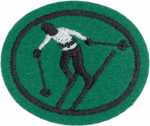Difference between revisions of "AY Honors/Skiing Downhill/Answer Key/es"
(Created page with "</noinclude> <!-- 1. Conocer las ventajas y desventajas de esquís acampanados y rectos. -->") |
(Created page with "</noinclude> <!-- 2. ¿Cómo el borde curvo de los esquís ayuda al esquiador a dar los giros? -->") |
||
| Line 53: | Line 53: | ||
{{ansreq|page={{#titleparts:{{PAGENAME}}|2|1}}|num=2}} | {{ansreq|page={{#titleparts:{{PAGENAME}}|2|1}}|num=2}} | ||
<noinclude></noinclude> | <noinclude></noinclude> | ||
| − | <!-- 2. | + | <!-- 2. ¿Cómo el borde curvo de los esquís ayuda al esquiador a dar los giros? --> |
| − | |||
<noinclude></noinclude> | <noinclude></noinclude> | ||
Revision as of 16:15, 8 February 2021
| Esquí alpino | ||
|---|---|---|
| Asociación General
|
Destreza: 2 Año de introducción: 1938 |
|
Requisitos
|
La especialidad de Esquí alpino es un componente de la Maestría Deportista. |
IMPORTANTE
1
2
3
At the time of the original downhill skiing honor the standard for ski size was as follows: The skis you use have to be to your elbow or to your wrist with an up arm stretch depending on how big you are. If you are heavy you should use long skis that reach to your wrist and if you are lightweight then you should use short skis that reach to your elbow.
4
The boot is the skier's vital link to the ski. The boot's design helps it to clip onto the boot and keeps it from twisting and turning. It gives the skier less stress knowing he doesn't have to worry about his skis falling off. It must allow the skier to flex forward firmly and comfortably. They must make the skier's feet warm in all climates, and they must be able to last several seasons.
5
A binding adjustment is a useful feature of the ski. Without it the skier would fall off the ski and slide around.
6
Safety straps and ski breaks have two major purposes. The first purpose is to keep the ski near the skier to keep him from losing the ski in the case that it comes off and slides down a slope. Otherwise, the skier will be stranded, or at least experience a greatly increased time in reaching the eventual destination. The second purpose is to keep the ski from becoming a moving hazard to other skiers. If no ski straps or break was on a ski, it would continue moving until something else stopped it. During its trip, it could move into the path of other skiers, causing them to make abrupt stops and turns, collide with objects or other people, or simply fall themselves. Any of these actions could cause injury to those other skiers.
7
If you see an injured skier, even from a distance, you should stop and help. If you are with a partner, one of you should go for ski patrol while the other stays with the person. If they are in a ski well, help them get their skis off. The potential of needing to know where to send help is a good reason to always keep track of what run you are on.
8
9
The original honor did not specify what equipment, but the South Pacific variant lists the following:
10
11
Referencias
- Categoría: Tiene imagen de insignia
- Adventist Youth Honors Answer Book/Honors/es
- Adventist Youth Honors Answer Book/es
- Adventist Youth Honors Answer Book/Skill Level 2/es
- Categoría: Libro de respuestas de especialidades JA/Especialidades introducidas en 1938
- Adventist Youth Honors Answer Book/General Conference/es
- Adventist Youth Honors Answer Book/Recreation/es
- Adventist Youth Honors Answer Book/Recreation/Primary/es
- Adventist Youth Honors Answer Book/Stage 0/es
- Adventist Youth Honors Answer Book/Sportsman Master Award/es
- Adventist Youth Honors Answer Book

